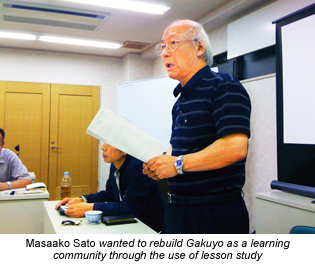Why Singapore’s English Teachers Should Embrace Singlish, Not Fight It
Is it time for Singaporean educators to embrace Singlish as a legitimate learning tool? What the Research […]
Read More
by Eisuke Saito
Find out how a veteran educator used lesson study to rebuild the learning culture in a Japanese school and what tips he has for Singapore school teachers embarking on lesson study.
Gakuyo Junior High School was badly in need of reform when Mr Masaaki Sato took over as principal. The teachers were burnt out. The students didn’t study. Some of them were even violent – students were refusing to attend classes because of classroom bullying and they feared for their safety.
Mr Sato wanted to guarantee opportunities for every student to learn meaningfully and for every teacher to grow as a professional. He wanted parents to participate in the learning process. He wanted to rebuild Gakuyo as a learning community.
 For the change to happen, Mr Sato used lesson study to introduce pedagogical reforms. The teachers were grouped into study teams. They made observations and reflections based on research findings and had informal discussions on lesson planning.
For the change to happen, Mr Sato used lesson study to introduce pedagogical reforms. The teachers were grouped into study teams. They made observations and reflections based on research findings and had informal discussions on lesson planning.
Lesson study teams are usually organized by subject departments. However, such teams tend to discuss only teaching methods, planning or subject matters. To encourage teachers to go beyond subject boundaries and think about their students and how they learn, Gakuyo’s teams were organized by grade levels.
Within 6 months, every student was participating in the learning process, when few of them had shown interest in their lessons before. Previously ranked 11th among 14 schools in the area, Gakuyo rose to become Number 3 within 2 years.
The reforms Mr Sato brought about in Gakuyo made him well known all over Japan. He is now a retired educational consultant and works with approximately 80 schools in the country, spending around 250 days a year participating in research lessons.
I met Mr Sato while working on a project with Science and Math teachers in Indonesia, way back in 2005. I struggled with a problem – the learning gained by Science and Math teachers was never shared with the rest of the teachers in the schools under the project.
Mr Sato’s experience showed me the direction. A systemic attempt involving the entire school would be necessary when introducing lesson study. This was a lesson I learned.
I invited Mr Sato to the places I was working in – Indonesia, Vietnam and Singapore. Since then, he has visited our island country thrice and worked with two schools here: Jurong Primary School and Hillgrove Secondary School.
Lesson study should not be seen as a fad. It has to be a long-term process of steady and continuous learning for teachers.
– Eisuke Saito, Curriculum, Teaching and Learning Academic Group
Teachers in both schools have been actively engaged in lesson study for the last couple of years. Mr Sato has expressed his pleasure at the schools’ progress since his first visit. He was very impressed with the collegiality and the strong leadership in both schools. Further, he was fascinated by the teachers’ caring attitudes and their enthusiasm in providing better education for their students.
At the same time, Mr Sato pointed out some concerns that the teachers could take up. He shared his points by showing scenes from videos that he recorded while observing lessons. They are universal, applicable not only in Singapore but also in other countries.
For example, while conducting lessons, teachers must observe how the students learn and improvise their teaching methods when needed. What should teachers do if students become confused or start to sleep in class? What should they do when some children in activity groups are still engaged in the activities when others have finished?
If some students don’t work with peers in pairs or groups, what should be done? When a group of children make a presentation and few listen, what kinds of habits should be developed through daily practice?
The teachers in these schools have certainly been doing a wonderful job. But there is one thing they cannot avoid – staff turnover. When important leaders are transferred out periodically, it is a great loss for the schools.
Teachers should, however, see the infusion of new colleagues as an opportunity. By explaining to these new members the goals, framework and reasons for lesson study, they can reaffirm the vision they want to pursue through the lesson study activities. They can also re-consider the method for achieving these goals.
Lesson study should not be seen as a fad. It has to be a long-term process of steady and continuous learning for teachers. However, to achieve that purpose, time is an important factor.
Mr Sato believes that the best analogy for the teaching profession is juggling. While teachers are already busy juggling their various duties, they now have another ball thrown in: lesson study!
Educators tend to think only about adding more work to their existing load. However, sometimes, it is important to consider taking away some work in order for them to fit in lesson study.
In the classroom, there are many “stories” of children and teachers unfolding concurrently. These can be very minor, but very important – much can be gleaned from them about our students. Without enough reflection, it is very difficult to improve the children and oneself. The practice of lesson study can help teachers to notice and capture those stories and reflect on them.